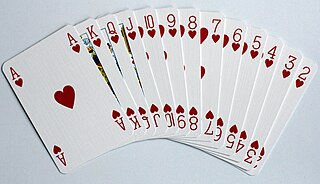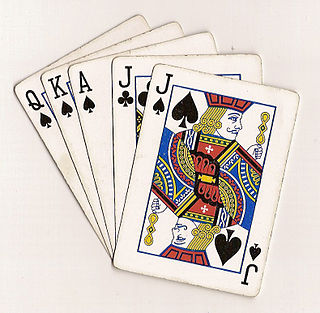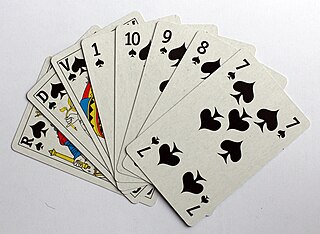Related Research Articles

Hearts is an "evasion-type" trick-taking playing card game for four players, although most variations can accommodate between three and six players. It was first recorded in America in the 1880s and has many variants, some of which are also referred to as "Hearts", especially the games of Black Lady and Black Maria. The game is a member of the Whist group of trick-taking games, but is unusual among Whist variants in that it is a trick-avoidance game; players avoid winning certain penalty cards in tricks, usually by avoiding winning tricks altogether. The original game of Hearts is still current but has been overtaken in popularity by Black Lady in the United States and Black Maria in Great Britain.

Oh hell or contract whist is a trick-taking card game of British origin in which the object is to take exactly the number of tricks bid. It was first described by B. C. Westall around 1930 and originally called oh! well. It was said to have been introduced into America via the New York clubs in 1931. Phillips and Westall describe it as "one of the best round games."

A trick-taking game is a card or tile-based game in which play of a hand centers on a series of finite rounds or units of play, called tricks, which are each evaluated to determine a winner or taker of that trick. The object of such games then may be closely tied to the number of tricks taken, as in plain-trick games such as contract bridge, whist, and spades, or to the value of the cards contained in taken tricks, as in point-trick games such as pinochle, the tarot family, briscola, and most evasion games like hearts. Trick-and-draw games are trick-taking games in which the players can fill up their hands after each trick. In most variants, players are free to play any card into a trick in the first phase of the game, but must follow suit as soon as the stock is depleted. Trick-avoidance games like reversis or polignac are those in which the aim is to avoid taking some or all tricks.

Whist is a classic English trick-taking card game which was widely played in the 18th and 19th centuries. Although the rules are simple, there is scope for strategic play.

Bezique or Bésigue is a 19th-century French melding and trick-taking card game for two players that came to Britain and is still played today. The game is derived from Piquet, possibly via Marriage (Sixty-six) and Briscan, with additional scoring features, notably the peculiar liaison of the and that is also a feature of Pinochle, Binokel, and similarly named games that vary by country.

Euchre or eucre is a trick-taking card game commonly played in Australia, Canada, Great Britain, New Zealand, and the Midwestern United States. It is played with a deck of 24, 28, or 32 standard playing cards. There are normally four players, two on each team, although there are variations for two to nine players.

Cassino, sometimes spelt Casino, is an English card game for two to four players using a standard, 52-card, French-suited pack. It is the only fishing game to have penetrated the English-speaking world. It is similar to the later Italian game of Scopa and is often said, without substantiation, to be of Italian origin. Cassino is still played today in Madeira, probably due to English influence.
Ruff and Honours, Ruffe and Trump or Slamm was an English trick-taking card game that was popular in the 16th and 17th centuries; it was superseded in the 18th century by Whist.
German whist is a variant of classic whist for two players in which the reward for winning the first 12 tricks is to add a particular card to your hand. Also called Chinese whist, it is probably of British origin.

Polignac is a French 18th century trick-taking card game ancestral to Hearts and Black Maria. It is played by 3-6 players with a 32-card deck. It is sometimes played as a party game with the 52-card pack; however, it is better as a serious game for four, playing all against all. Other names for this game include Quatre Valets and Stay Away. Knaves is a variant and it is also similar to the Austrian and German games, Slobberhannes, Eichelobern and Grasobern.

Twenty-five is the Irish national card game, which also underlies the Canadian game of Forty-fives. Charles Cotton describes its ancestor in 1674 as "Five Cards", and gives the nickname five fingers to the Five of Trumps extracted from the fact that the Irish word cúig means both 'five' and 'trick'. It is supposed to be of great antiquity, and widely believed to have originated in Ireland, although "its venerable ancestor", Maw, of which James I of England was very fond, is a Scottish game.
Cinch, also known as Double Pedro or High Five, is an American trick-taking card game of the All Fours family derived from Auction Pitch via Pedro. Developed in Denver, Colorado in the 1880s, it was soon regarded as the most important member of the All Fours family in the USA, but went out of fashion with the rise of Auction Bridge. The game is primarily played by 4 players in fixed partnerships, but can also be played by 2–6 individual players.
Catch the Ten, also called Scots Whist or Scotch Whist, is an 18th-century point-trick, Ace-Ten card game which is recorded as being played only in Scotland, although evidence suggests a possible German origin. Unlike standard Whist, it is played with a pack of only 36 cards, the 5s and below being omitted. In the trump suit, the Jack is the highest card. Despite its alternative name, it has nothing to do with standard Whist.

Napoleon or Nap is a straightforward trick-taking game in which players receive five cards each and whoever bids the highest number of tricks chooses trumps and tries to win at least that number of tricks. It is often described as a simplified version of Euchre, although David Parlett believes it is more like "an elaboration of Rams". It has many variations throughout Northern Europe, such as Fipsen. The game has been popular in England for many years, and has given the language a slang expression, "to go nap", meaning to take five of anything. It may be less popular now than it was, but it is still played in some parts of southern England and in Strathclyde. Despite its title and allusions, it is not recorded before the last third of the nineteenth century, and may have been first named after Napoleon III.

Klaverjas or Klaverjassen is a Dutch, four player, trick-taking card game that uses a Piquet pack of 32 playing cards. It is closely related to the internationally popular card game of Klaberjass. Klaverjas is one of the most popular card games in the Netherlands, traditionally played in cafes and social clubs. The game offers a considerable level of complexity and depth. It has numerous variants, but its basic rules are universal.

Rams is a European trick-taking card game related to Nap and Loo, and may be played by any number of persons not exceeding nine, although five or seven make a good game. In Belgium and France, the game of Rams is also spelt Rammes or Rems, in Germany, Rams, Rammes, Ramsch, Ramschen, Ramscheln or Ramsen, in Austria, Ramsen and Ramschen, and, in America, Rounce. The basic idea is fairly constant, but scoring systems vary. It was a widespread European gambling and drinking game that is still popular today. During the 19th century, it was introduced as Rounce in America and played with a 52-card deck without any difference between simples and doubles and with no General Rounce announcement. In the modern German variety of the game, Ramscheln, the 7♦ is the second best trump ranking next below the ace.

The following is a glossary of terms used in card games. Besides the terms listed here, there are thousands of common and uncommon slang terms. Terms in this glossary should not be game-specific, but apply to a wide range of card games played with non-proprietary packs. It should not include terms solely related to casino or banking games. For glossaries that relate primarily to one game or family of similar games, see Game-specific glossaries.

Triomphe, once known as French ruff, is a card game dating from the late 15th century. It most likely originated in France or Spain and later spread to the rest of Europe. When the game arrived in Italy, it shared a similar name with the pre-existing game and deck known as trionfi; probably resulting in the latter becoming renamed as Tarocchi (tarot). While trionfi has a fifth suit that acts as permanent trumps, triomphe randomly selects one of the existing four suits as trumps. Another common feature of this game is the robbing of the stock. Triomphe became so popular that during the 16th century the earlier game of trionfi was gradually renamed tarocchi, tarot, or tarock. This game is the origin of the English word "trump" and is the ancestor of many trick-taking games like Euchre and Whist. The earliest known description of Triomphe was of a point-trick game, perhaps one of the earliest of its type; later, the name was applied to a plain-trick game.

Newmarket is an English card game of the matching type for any number of players. It is a domestic gambling game, involving more chance than skill, and emerged in the 1880s as an improvement of the older game of Pope Joan. It became known in America as Stops or Boodle before developing into Michigan. In 1981, Newmarket was still the sixth most popular card game in Britain.
Maw, formerly also Mawe, was a Scottish card game for two players, popularised by James I, which is ancestral to the Irish national game of Twenty-five as well as the Canadian game of Forty-fives. Maw appears to be the same as Five Cards, a game described by Charles Cotton in the 17th century. The game disappeared from the literature after the period of the English Commonwealth, only to emerge in Ireland in the 19th century in new forms for two or more players and known as Five and Ten, Spoil Five and Forty-Five. These new variants are still played today, the latter has evolved into the Canadian game of Forty-fives.